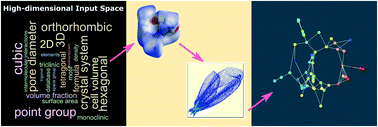当前位置:
X-MOL 学术
›
Mol. Syst. Des. Eng.
›
论文详情
Our official English website, www.x-mol.net, welcomes your feedback! (Note: you will need to create a separate account there.)
Correlative analysis of metal organic framework structures through manifold learning of Hirshfeld surfaces†
Molecular Systems Design & Engineering ( IF 3.6 ) Pub Date : 2018-08-16 00:00:00 , DOI: 10.1039/c8me00014j Xiaozhou Shen 1, 2, 3, 4 , Tianmu Zhang 1, 2, 3, 4 , Scott Broderick 1, 2, 3, 4 , Krishna Rajan 1, 2, 3, 4
Molecular Systems Design & Engineering ( IF 3.6 ) Pub Date : 2018-08-16 00:00:00 , DOI: 10.1039/c8me00014j Xiaozhou Shen 1, 2, 3, 4 , Tianmu Zhang 1, 2, 3, 4 , Scott Broderick 1, 2, 3, 4 , Krishna Rajan 1, 2, 3, 4
Affiliation

|
We demonstrate the use of non-linear manifold learning methods to map the connectivity and extent of similarity between diverse metal–organic framework (MOF) structures in terms of their surface areas by taking into account both crystallographic and electronic structure information. The fusing of geometric and chemical bonding information is accomplished by using 3-dimensional Hirshfeld surfaces of MOF structures, which encode both chemical bonding and molecular geometry information. A comparative analysis of the geometry of Hirshfeld surfaces is mapped into a low-dimensional manifold through a graph network where each node corresponds to a different compound. By examining the nearest neighbor connections, we discover structural and chemical correlations among MOF structures that would not have been discernible otherwise. Examples of the types of information that can be uncovered using this approach are given.
中文翻译:

通过Hirshfeld表面的多重学习对金属有机框架结构进行相关分析†
我们展示了非线性流形学习方法的使用,通过同时考虑晶体学和电子结构信息,可以按照表面积来映射各种金属-有机框架(MOF)结构之间的连通性和相似程度。几何和化学键信息的融合是通过使用MOF结构的3维Hirshfeld表面完成的,该表面对化学键和分子几何信息进行编码。通过图形网络将Hirshfeld曲面的几何结构的比较分析映射到低维流形,其中每个节点对应于一个不同的化合物。通过检查最近的邻居连接,我们发现MOF结构之间的结构和化学相关性,否则将无法辨别。
更新日期:2018-08-16
中文翻译:

通过Hirshfeld表面的多重学习对金属有机框架结构进行相关分析†
我们展示了非线性流形学习方法的使用,通过同时考虑晶体学和电子结构信息,可以按照表面积来映射各种金属-有机框架(MOF)结构之间的连通性和相似程度。几何和化学键信息的融合是通过使用MOF结构的3维Hirshfeld表面完成的,该表面对化学键和分子几何信息进行编码。通过图形网络将Hirshfeld曲面的几何结构的比较分析映射到低维流形,其中每个节点对应于一个不同的化合物。通过检查最近的邻居连接,我们发现MOF结构之间的结构和化学相关性,否则将无法辨别。



























 京公网安备 11010802027423号
京公网安备 11010802027423号